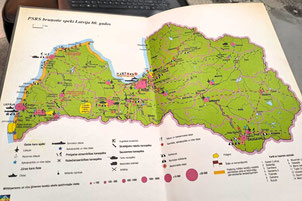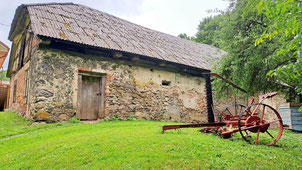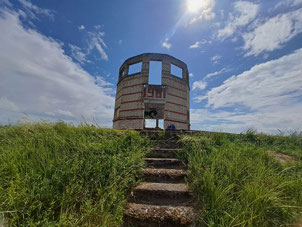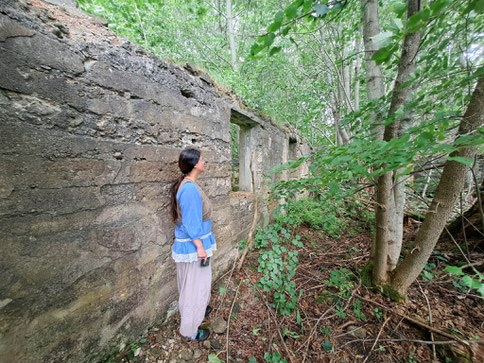Latvia's bomb-blasted paradise

It has been said that in the Baltic countries, the Second World War didn't end until the last Russian troops left in the 1990s. And in one benighted corner of Latvia, devastating explosions continued to wreak havoc right up until that long-overdue departure.
This was the fate of Zvārdes Parish, a 205 square kilometre rural area just south of Saldus in Kurzeme. For nearly four decades, it was used by the Soviet air force as a bombing range, uprooting a prosperous community and ruining some of the country's most fertile land.
A trek through this violated territory is a bleak reminder of the stupidity and brutality of rampant militarism. But it is also an inspiring example of the resilience of both nature and human beings.
On the warpath

Zvārde Parish is about 125 kilometres southwest of Riga, just off the A9 highway to Liepāja. This is a journey though both time and road miles, so some historical background is essential.
At the start of your trip, pop into the Riga Aviation Museum, just behind Riga Airport in the village of Skulte. Housed on a former Soviet military airbase, the dozens of red-starred war machines played a key role in the atrocities inflicted further to the west.

Continuing on, there are vivid reminders of the toll of war inflicted on Latvia in the 20th century.
At Ložmtējkalns (Machine Gun Hill), the Latvian Rifle Regiments fought bloody battles during the First World War.
In Lestene, there is a monument to the thousands of Latvian Legionnaires killed in the Courland Pocket in 1944-45. Next to this sombre site is the local Lutheran church. Its unique woodcarvings were badly damaged by war and communist neglect, but are being gradually restored.
Target: Zvārde

Under Soviet occupation, Kurzeme sat on the western border of the USSR. Accordingly, it was turned into one of the most heavily militarised regions in the world.
The map displayed here is from the book "Latvia - Soviet Military Base, 1939-1998" (Riga, Zelta grauds, 2006), and it shows the deployment of Soviet forces in Latvia in the 1980s. It is clear to see that he naval ports, airfields, tank units and nuclear missile sites were heavily concentrated in Kurzeme. The photo shows Soviet submarines rotting in Liepāja's Karosta naval base in the 1990s.

Zvārde Parish suffered especially badly under these oppressive conditions. First occupied by the Germans in 1915, it recovered in the first independent republic to become a thriving farming centre, with churches, schools, community centres and other amenities serving 3,000 hardworking residents.
Tragically, it was on the front line of the Courland Pocket for six months, and 90 percent of its buildings were destroyed.

After the war, the local people returned to their shattered homes. But adding to their problems, the communist regime imposed crippling taxes to force reluctant Latvians to join the collective farms. Anti-Soviet partisans mounted a guerrilla campaign from the forests against the occupiers. Then, between March 25 and 29, 1949, the Kremlin took a savage step to liquidate support for the forest brothers and impose collectivisation once and for all. Around 90,000 Baltic farmers were deported to the Gulag, half of them Latvians.
Over one hundred Zvārde residents met this fate. One of them was Dzidra Lāce, a local farmer's daughter. After returning from Siberia in 1957, she began to secretly interview former residents of Zvārde about what happened to the district. In the 1990s, she did more archival research, eventually publishing the book "Zvārde Parish over the Centuries" in 2017.

Lāce describes how, between1953 and 1955, the remaining residents were forced out of their homes and relocated to collective farms elsewhere in the district. For the next 40 years, the sounds of birdsong and cattle lowing were replaced by jet engines and earth trembling explosions.
Bombers like the Tupolev Tu-22 pictured here flew over 100 sorties a day. Approaching at speeds between 900 and 1,400 kilometres per hour, they dropped a mixture of "practice bombs" filled with sand and live ordinance. A hit within 100 metres of the target was regarded as good, and 1,700 metres was satisfactory. Mishaps were not uncommon, with bombs even falling 10 kilometres away in densely-populated Saldus (fortunately without exploding).
Workers from the neighbouring collective farms were roped into cutting hay in the target area in order to prevent grass fires. Several people doing this hazardous job were killed or injured by stray munitions.
During the movement to restore Latvia's independence, the people of Zvārde campaigned to stop the bombing. On July 21, 1990, with the consent of the military authorities, they brought white crosses into the area to commemorate their losses. On November 18 of that same year, they formed a human chain around the target range.
On January 11, 1993, the Russian military finally pulled out, and Latvia's parliament voted to officially re-establish Zvārde Parish as an administrative entity. Despite a lack of roads and electricity, and well aware of hidden dangers (from leftover World War Two shells as well as Soviet bombs), farmers began returning to their ancestral properties.
Exploring Ground Zero

Nine kilometres south of Saldus, the village of Striķi was just outside the bombing range. Today it is the municipal centre of Zvārde Parish. Its historic stone buildings and well-tended manor park offer a glimpse of the area's former beauty.
There are quite a few farms and logging outfits around the village. The range itself is largely wilderness, with a few isolated settlements, but the gravel roads are in good condition.

A memorial stone in Striķi is dedicated "To the memory of the victims of the totalitarian regimes."

The epicentre of the bombing range covered around 12,000 hectares. The approaching aircraft were guided by Soviet air force officers from a now-crumbling brick tower. Situated on a high artificial hill, there are panoramic views from the top.

The central aiming point for the bombers was Rīteļu Cemetery. Most of the graves were completely destroyed by the explosions and repeated bulldozing of craters. A stone bears the haunting inscription, "Forgive us for not protecting you."

Another moving memorial is Zvārde Lutheran Church. Benches and a simple cross have been situated between the remnants of the stone walls, and services are held here in summer.
Proceed with caution

Signs around the epicentre warn visitors about unexploded ordinance. In particular, Rīteļu Cemetery has not been thoroughly cleared because of the large amount of shrapnel in the soil, so stay on the pathway.
At the same time, farmers, loggers and hunters move freely around the area. We talked to several locals, and they believe the risk of encountering unexploded ordinance is low. If you do spot something suspicious, stay well clear and notify the police.

However, this should not frighten visitors away. Today, the parish is a stunning landscape of wildflowers, birds, woods and lakes. Black currant bushes gone wild offer juicy berries. The mushroom haul in autumn must be rich, too.
There are also some well-maintained beaches where you can plunge into the pristine waters. Hopefully that will be the biggest splash made in Zvārde from now on.
Planning your trip

- Striķi is about 90 minutes drive from Riga. Two buses a day go to the village from Saldus. The roads in the parish are mostly gravel-covered but you could cycle the area with a decent mountain bike.
- A few kilometres north of Striķi, farmer and motoring enthusiast Jānis Dobele has assembled a cool collection of Soviet cars, trucks and motorbikes. Contact him on +371 2705 7027.
- There are beautiful picnic spots in Zvārde Parish, but the closest cafes are in Saldus. Coffee Shop Tase is a lovely little place.
- Contact me for daytrips to Kurzeme and Riga Soviet history tours.
Map of Zvārde Bombing Range
More Latvian Road Trips

Discover the Livonian heritage of the wild north-west coast!

